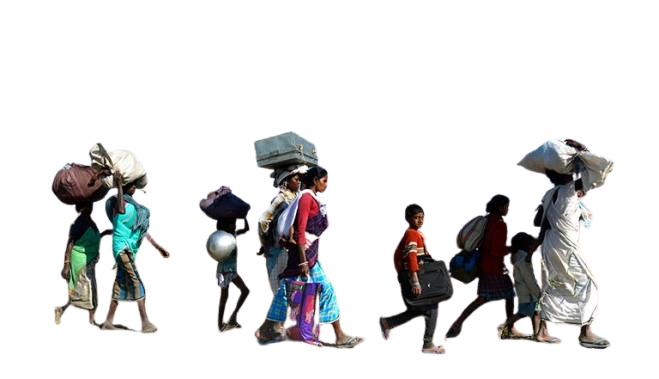| Smash 2025 FLT 05 Q8. Empowerment of tribal communities requires shifting from top-down policies to bottom-up participation. Examine the extent to which current governance models enable this shift. |
| PYQ Q. Given the diversities among tribal communities in India, in which specific contexts should they be considered as a single category? (2022) |
Tribal communities (8.6% of India’s population, Census 2011) live in resource-rich but economically poor regions. Post-independence, much of India’s developmental trajectory has led to tribal displacement, making rehabilitation the dominant state response.
Tribal Development in India: Displacement and Rehabilitation
Displacement
- Large Dams & Irrigation Projects – Submergence of tribal villages. Eg– Sardar Sarovar Dam displaced ~40,000 families in Madhya Pradesh, Gujarat, Maharashtra.
- Mining & Industrial Projects – Resource-rich tribal belts face land alienation. Eg– Niyamgiri Hills mining (Odisha) threatened Dongria Kondhs; coal mining in Chhattisgarh displaced Gond tribals.
- Wildlife & Conservation Policies – Eviction from forests under protected areas. Eg– Tiger Reserves like Kanha, Simlipal, Nagarhole forced relocation of tribal hamlets.
- Urban Expansion & Infrastructure – Highways, SEZs, power plants displace tribal settlements. Eg– POSCO steel project (Odisha) displaced betel farmers, many from tribal backgrounds.
- Environmental Projects – Afforestation under CAMPA led to occupation of FRA land. Eg– Chhattisgarh protests (2021) against afforestation on tribal cultivable land.
Rehabilitation
- Compensation Packages – Land-for-land or cash payments. Eg– Narmada Rehabilitation Policy promised land to displaced families (though implementation was uneven).
- National Rehabilitation & Resettlement Policy (2007) – Guidelines for humane resettlement, skill training, housing, and livelihood restoration.
- Forest Rights Act (2006) – Recognition of individual and community rights over forest land. Eg– Dongria Kondhs protected rights against Vedanta mining in Niyamgiri.
- Livelihood Support – Skill-building, agricultural land allocation, and jobs in development projects. Eg– Coal India’s policy of providing employment to one family member of displaced.
- Social Infrastructure – Resettlement colonies with housing, schools, healthcare. Eg– Resettlement under R&R for Tehri Dam included townships with basic amenities.
Beyond Displacement and Rehabilitation: Towards Empowerment
- Guiding Philosophy: Nehru’s Tribal Panchsheel Policy – Principles included: respect for tribal culture, development along tribal genius, training in self-governance, not over-administering, and building confidence in tribals.
- Constitutional Safeguards – Fifth & Sixth Schedules provide self-governance, autonomy in tribal regions.
- Legal Empowerment
- PESA Act, 1996 empowers Gram Sabhas in Scheduled Areas to decide on resources and projects.
- Forest Rights Act, 2006 secures land and community forest rights.
- Eg– Dongria Kondhs’ Gram Sabha vetoed Vedanta’s mining project in Niyamgiri Hills (2013).
- Socio-Economic Development Schemes – Vanbandhu Kalyan Yojana, TRIFED for minor forest produce, Eklavya Model Residential Schools for education.
- Cultural Preservation- Eg– Warli painting (Maharashtra), Gond art (Madhya Pradesh) supported under TRIFED.
- Health & Nutrition Focus – Eg– Poshan Abhiyaan with special focus on tribal districts.
- Political Representation – Eg– ST reservation in Lok Sabha and State Assemblies; 50% seats in some Panchayats reserved for women, including tribal women.
Way Forward
- Livelihood Diversification – Promote eco-friendly livelihoods such as bamboo, lac, honey, eco-tourism, minor forest produce with MSP and market linkages through TRIFED.
- Inclusive Development Planning – Institutionalize Free, Prior and Informed Consent (FPIC) in all projects affecting tribal areas, ensuring genuine participation.
- Climate & Resilience Building – Make tribal communities partners in afforestation, watershed management, and renewable energy projects, linking them with green jobs.
- Cultural Tourism Corridors – Develop tribal heritage circuits (like Bastar, Nagaland, Meghalaya) to generate revenue while preserving identity.
- Xaxa Committee on Tribal Development (2014) – Recommended protection against alienation, better health and education delivery, and promotion of tribal languages in schooling.
- N.C. Saxena Committee on Forest Rights Act (2010) – Recommended simplified claim verification, community forest management, and avoiding forced evictions.
Tribal development in India must move from a “reactive approach of rehabilitation” to a “proactive model of empowerment”. As Verrier Elwin argued, true tribal development means protecting roots while expanding wings.


